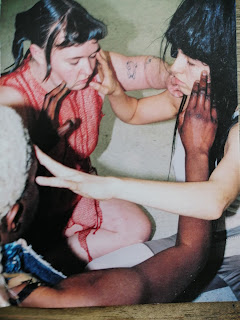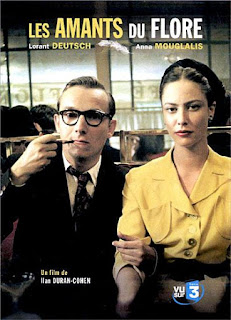Afterlife by Louis Shou-Hansen & Karoline Bakken Lund
Last Sunday, despite my exhaustion, I grabbed my red bike and went to Palmera to watch Afterlife by Louis Shou-Hansen & Karoline Bakken Lund.
It has been a while since I experienced a live dance storytelling event. I know that not everyone would describe Afterlife with these words. But that was it for me. Storytelling through dance, alive. Walter Benjamin's words about the aura of a piece of art being unreproducible caught me, while I was sitting on my pillow, fighting my tiredness. Trying to stay awake to witness what was happening in front of me.
I had a chance to experience something unique happening. Three women, with and in their bodies were telling a story. A story without a clear beginning or an end. A story constantly flirting with "what if". An invention that was born from a return to the past. Classical ballet is dead. What if?
I do not have the pretension of being able to tell you which story/stories they told. Instead, what I will be sharing here is how I received what I saw, heard, smelled, and felt in and with my tired body, brain, and soul.
Benjamin also makes a distinction between two different modes in which one can be while appreciating art. One can approach art with concentration or distracted. I was in between both modes. I wanted to concentrate and be there with Afterlife. But I was also so tired and still aware of everything else I had to do. So it was very difficult to stop the internal machine inside of me, trying to find space for all that need to be done. Glimpses of concentration followed by minutes of distraction put me in a place where I was able to see the exposure of bodies. Some bodies were more exposed than others. But all the costumes were made to make those bodies visible. Pieces of the bodies that often women are told that they need to hide, be ashamed of, or even remove were visible and exposed. I received the costume decision as part of the desire of the artists to question the norms of how bodies (especially female bodies) should be presented in this life.
Another element of Afterlife that stayed with me was the dance of eyes. Part of the common dynamic of the dancers was to rearrange themselves into smaller groups of two, leaving one dancer out. This exclusion of one of them from the center of the scene created some of the most powerful moments of this performance for me. In between concentration and distraction, I chose to follow the eyes that occupied the periphery of that happening and I saw a smashing metaphor of how exclusion can break a person, can remove her capacity to move, to stand, to be alive.
Once more, I am not sharing with you what Afterlife is. If you want to read a descriptive presentation of this piece, I suggest you check this out. Here I am sharing what stayed with me. Silence also stayed. Afterlife's soundtrack was at times noisy as if made to make us uncomfortable and at times, silly, as an invitation to laugh. In between, here and there, minutes of silence. I was surprised to see how much those windows of silence gave me. It gave me room to start digesting what was going on in front of my tired self. With silence, I could carry their gestures into my bag of obsessions. Mixed up they gave me this loose sentence "yes, our way of loving is still violent". The whole cupid idea, still present in our imagination, represents this violence in a nutshell, perhaps.
Afterlife lasted for one hour. Three bodies dancing what did not arrive here. A gesture inviting our imaginations to host the impossible. 'What if' occupied by some of the ugliest, smelliest bits of the existent history of classic ballet. A history marked by violence, exclusion, and the imposition of an ideal body that is seen as the only one allowed to dance. Afterlife at times made me laugh. Especially in the bits where folk dances were mixed up with kisses and other funny unexpected ways of modern touch (like high fives). Most of all Afterlife reminded me that we all have the right to dance. I left Palmera thinking of Maya Angelou's dance and poetry and occupied by the fragile certainty that dance can be a prayer and a love letter to the world and to ourselves.




Comments
Post a Comment